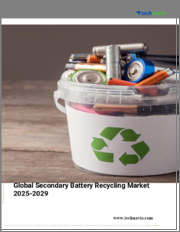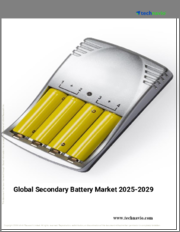
|
시장보고서
상품코드
1679565
이차전지 시장 규모, 점유율, 동향 분석 보고서(2025-2030년) : 유형별, 용도별, 지역별 부문 예측Secondary Battery Market Size, Share & Trends Analysis Report By Type (Lithium-ion, Lead Acid, Nickel Metal Hydride), By Application (Motor Vehicles, Industrial Batteries, Portable Devices, Electronics), By Region, And Segment Forecasts, 2025 - 2030 |
||||||
이차전지 시장의 성장과 동향
Grand View Research, Inc.의 최신 보고서에 따르면 세계 이차전지 시장 규모는 2030년까지 2,071억 9,000만 달러에 이를 것으로 예측되며, 예측 기간 동안 CAGR 9.4%로 확대될 것으로 예측됩니다. 이차전지 수요는 전기자동차(EV)의 급속한 보급, 재생 가능 에너지 저장 시스템의 확대, 휴대용 전자기기의 사용 증가로 향후 수년간 크게 성장할 것으로 보입니다. 세계 각국 정부는 엄격한 배출 규제를 시행하고 청정 에너지 솔루션에 대한 인센티브를 제공하고 있으며, 이는 효율적인 에너지 저장의 필요성을 더욱 높이고 있습니다.
리튬 이온 배터리 부문은 고에너지 밀도, 긴 사이클 수명, 급속 충전 기능을 무기로 최대 유형 부문으로 성장하고 있습니다. 또한 스마트폰, 노트북, 웨어러블 기기 등의 소비자용 전자기기 제품의 보급도 소비자가 보다 긴 배터리 수명과 고속 충전을 요구하고 있기 때문에 수요를 뒷받침하고 있습니다. 이러한 요인들이 결합되어 리튬 이온 배터리는 지속 가능한 에너지와 첨단 기술로의 세계적인 전환을 가능하게 하는 중요한 존재가 되고 있습니다.
이차전지 산업의 휴대기기 부문은 스마트폰, 노트북, 태블릿, 웨어러블 디바이스 수요 증가에 의해 견인되어 일, 교육, 여가 생활에서의 기술 의존성 고조가 그 원동력이 되고 있습니다. 소비자는 더 긴 배터리 수명, 더 빠른 충전 속도, 컴팩트한 디자인의 장치를 찾고 있으며, 이는 리튬 이온 및 기타 배터리 기술의 발전을 뒷받침하고 있습니다.
이차전지산업은 전기자동차(EV) 수요 증가, 신재생에너지 저장 솔루션의 확대, 소비자용 전자기기 제품의 채용 증가에 의해 견인되고 있습니다. 세계 각국의 정부는 전지 생산과 전동화를 지원하는 시책과 인센티브를 실시하고 있으며, 이는 시장 성장을 더욱 가속화하고 있습니다.
이차전지 시장 보고서 하이라이트
- 유형별로는 리튬 이온 배터리가 2024년에 78.15% 이상의 최대 판매 점유율을 차지했습니다. 리튬 이온 배터리는 시장의 핵심이며 주로 전기자동차(EV)의 급속한 보급에 의해 견인되고 있습니다. EV는 고에너지 밀도, 긴 사이클 수명 및 급속 충전 기능을 갖춘 리튬 이온 배터리에 크게 의존합니다.
- 용도별로는 자동차 부문이 2024년에 33.65% 이상의 매출 점유율을 차지했습니다. 세계 각국 정부는 엄격한 배기 가스 규제를 실시하고 청정 에너지 수송을 촉진하는 인센티브를 제공하고 있으며, 이는 고성능 배터리 중에서도 특히 리튬 이온 배터리 수요를 가속화하고 있습니다.
- 아시아태평양은 중국, 인도, 일본 등 국가의 정부 시책, 보조금, 엄격한 배기가스 규제가 원동력이 되어 예측 기간 중 가장 높은 CAGR로 성장할 것으로 예상됩니다.
목차
제1장 조사 방법과 범위
제2장 주요 요약
제3장 시장의 변수, 동향, 범위
- 시장 계통의 전망
- 침투와 성장의 전망 매핑
- 밸류체인 분석
- 규제 프레임워크
- 표준 및 컴플라이언스
- 규제의 영향 분석
- 시장 역학
- 시장 성장 촉진요인 분석
- 시장 성장 억제요인 분석
- 시장 기회
- 시장의 과제
- Porter's Five Forces 분석
- 공급자의 협상력
- 구매자의 협상력
- 대체 위협
- 신규 참가업체의 위협
- 경쟁 기업간 경쟁 관계
- PESTLE 분석
- 정치
- 경제
- 사회
- 기술
- 환경
- 법률
제4장 이차전지 시장 : 유형별, 추정 및 동향 분석
- 이차전지 시장 : 유형 변동 분석(2024년 및 2030년)
- 리튬 이온
- 납축전지
- 니켈 수소
- 기타
제5장 이차전지 시장 : 용도별, 추정 및 동향 분석
- 이차전지 시장 : 용도 변동 분석(2024년 및 2030년)
- 자동차
- 산업용 전지
- 휴대용 장치
- 일렉트로닉스
- 기타
제6장 이차전지 시장 : 지역별, 추정 및 동향 분석
- 지역 분석(2024년 및 2030년)
- 북미
- 유형별(2018-2030년)
- 용도별(2018-2030년)
- 미국
- 캐나다
- 멕시코
- 유럽
- 유형별(2018-2030년)
- 용도별(2018-2030년)
- 독일
- 영국
- 프랑스
- 아시아태평양
- 유형별(2018-2030년)
- 용도별(2018-2030년)
- 중국
- 인도
- 일본
- 한국
- 중남미
- 유형별(2018-2030년)
- 용도별(2018-2030년)
- 브라질
- 중동 및 아프리카
- 유형별(2018-2030년)
- 용도별(2018-2030년)
- 사우디아라비아
- 아랍에미리트(UAE)
제7장 경쟁 구도
- 주요 시장 진출기업에 의한 최근 동향
- 기업 분류
- 주요 부품 공급업체 및 채널 파트너 목록
- 기업의 시장 점유율과 포지셔닝 분석(2024년)
- 히트맵 분석
- 벤더 상황
- 원료 공급업체 목록
- 유통업체/무역업체 일람
- 기타 주요 제조업체 일람
- 잠재 최종 사용자 일람
- 전략 매핑
- 기업 프로파일/상장 기업
- LG Chem
- Hitachi High-Tech India Private Limited
- Aquion Energy LLC
- Johnson Controls
- BTI
- Amperex Technologies
- Panasonic Corporation
- BYD Company Ltd.
- SAMSUNG SDI CO., LTD.
- Energizer Holdings Inc.
Secondary Battery Market Growth & Trends:
The global secondary battery market size is anticipated to reach USD 207.19 billion by 2030 and is anticipated to expand at a CAGR of 9.4% during the forecast period, according to a new report by Grand View Research, Inc. The demand for secondary batteries is likely to grow significantly in the coming years, driven by the rapid adoption of electric vehicles (EVs), the expansion of renewable energy storage systems, and the increasing use of portable electronic devices. Governments worldwide are implementing stringent emission regulations and offering incentives for clean energy solutions, further boosting the need for efficient energy storage.
The lithium-ion battery sector is the largest type segment, fueled by high energy density, long cycle life, and fast charging capabilities. The proliferation of consumer electronics, including smartphones, laptops, and wearable devices, also fuels demand, as consumers seek longer battery life and faster charging. Together, these factors position lithium-ion batteries as a critical enabler of the global transition to sustainable energy and advanced technology.
The portable devices segment in the secondary battery industry is driven by the increasing demand for smartphones, laptops, tablets, and wearable devices, fueled by the growing reliance on technology for work, education, and entertainment. Consumers are seeking devices with longer battery life, faster charging, and compact designs, pushing advancements in lithium-ion and other battery technologies.
The secondary battery industry is driven by the growing demand for electric vehicles (EVs), the expansion of renewable energy storage solutions, and increasing consumer electronics adoption. Governments worldwide are implementing policies and incentives to support battery production and electrification, further accelerating market growth.
Secondary Battery Market Report Highlights:
- Based on type, Lithium-ion Batteries held the largest revenue share of over 78.15% in 2024. Lithium-ion batteries are the cornerstone of the market, driven primarily by the rapid adoption of electric vehicles (EVs), which rely heavily on these batteries for their high energy density, long cycle life, and fast charging capabilities.
- Based on applications, Motor vehicles segment held the revenue share of over 33.65% in 2024. Governments worldwide are implementing stringent emission regulations and offering incentives to promote clean transportation, accelerating the demand for high-performance batteries, particularly lithium-ion.
- Asia Pacific is expected to grow at fastest CAGR over the forecast period, driven by fueled by government policies, subsidies, and stringent emission regulations in countries like China, India, and Japan.
Table of Contents
Chapter 1. Methodology and Scope
- 1.1. Market Segmentation & Scope
- 1.2. Market Definition
- 1.3. Information Procurement
- 1.3.1. Information Analysis
- 1.3.2. Market Formulation & Data Visualization
- 1.3.3. Data Validation & Publishing
- 1.4. Research Scope and Assumptions
- 1.4.1. List of Data Sources
Chapter 2. Executive Summary
- 2.1. Market Snapshot
- 2.2. Segmental Outlook
- 2.3. Competitive Outlook
Chapter 3. Market Variables, Trends, and Scope
- 3.1. Market Lineage Outlook
- 3.2. Penetration & Growth Prospect Mapping
- 3.3. Value Chain Analysis
- 3.4. Regulatory Framework
- 3.4.1. Standards & Compliance
- 3.4.2. Regulatory Impact Analysis
- 3.5. Market Dynamics
- 3.5.1. Market Driver Analysis
- 3.5.2. Market Restraint Analysis
- 3.5.3. Market Opportunities
- 3.5.4. Market Challenges
- 3.6. Porter's Five Forces Analysis
- 3.6.1. Bargaining Power of Suppliers
- 3.6.2. Bargaining Power of Buyers
- 3.6.3. Threat of Substitution
- 3.6.4. Threat of New Entrants
- 3.6.5. Competitive Rivalry
- 3.7. PESTLE Analysis
- 3.7.1. Political
- 3.7.2. Economic
- 3.7.3. Social Landscape
- 3.7.4. Technology
- 3.7.5. Environmental
- 3.7.6. Legal
Chapter 4. Secondary Battery Market: Type Estimates & Trend Analysis
- 4.1. Secondary Battery Market: Type Movement Analysis, 2024 & 2030
- 4.2. Lithium-ion
- 4.2.1. Market estimates and forecasts, 2018 - 2030 (USD Million)
- 4.3. Lead acid
- 4.3.1. Market estimates and forecasts, 2018 - 2030 (USD Million)
- 4.4. Nickel Metal Hydride
- 4.4.1. Market estimates and forecasts, 2018 - 2030 (USD Million)
- 4.5. Others
- 4.5.1. Market estimates and forecasts, 2018 - 2030 (USD Million)
Chapter 5. Secondary Battery Market: Application Estimates & Trend Analysis
- 5.1. Secondary Battery Market: Application Movement Analysis, 2024 & 2030
- 5.2. Motor Vehicles
- 5.2.1. Market estimates and forecasts, 2018 - 2030 (USD Million)
- 5.3. Industrial Batteries
- 5.3.1. Market estimates and forecasts, 2018 - 2030 (USD Million)
- 5.4. Portable Devices
- 5.4.1. Market estimates and forecasts, 2018 - 2030 (USD Million)
- 5.5. Electronics
- 5.5.1. Market estimates and forecasts, 2018 - 2030 (USD Million)
- 5.6. Other Applications
- 5.6.1. Market estimates and forecasts, 2018 - 2030 (USD Million)
Chapter 6. Secondary Battery Market: Regional Estimates & Trend Analysis
- 6.1. Regional Analysis, 2024 & 2030
- 6.2. North America
- 6.2.1. Market estimates and forecasts, 2018 - 2030 (USD Million)
- 6.2.2. Market estimates and forecasts, by type, 2018 - 2030 (USD Million)
- 6.2.3. Market estimates and forecasts, by application, 2018 - 2030 (USD Million)
- 6.2.4. U.S.
- 6.2.4.1. Market estimates and forecasts, 2018 - 2030 (USD Million)
- 6.2.4.2. Market estimates and forecasts, by type, 2018 - 2030 (USD Million)
- 6.2.4.3. Market estimates and forecasts, by application, 2018 - 2030 (USD Million)
- 6.2.5. Canada
- 6.2.5.1. Market estimates and forecasts, 2018 - 2030 (USD Million)
- 6.2.5.2. Market estimates and forecasts, by type, 2018 - 2030 (USD Million)
- 6.2.5.3. Market estimates and forecasts, by application, 2018 - 2030 (USD Million)
- 6.2.6. Mexico
- 6.2.6.1. Market estimates and forecasts, 2018 - 2030 (USD Million)
- 6.2.6.2. Market estimates and forecasts, by type, 2018 - 2030 (USD Million)
- 6.2.6.3. Market estimates and forecasts, by application, 2018 - 2030 (USD Million)
- 6.3. Europe
- 6.3.1. Market estimates and forecasts, 2018 - 2030 (USD Million)
- 6.3.2. Market estimates and forecasts, by type, 2018 - 2030 (USD Million)
- 6.3.3. Market estimates and forecasts, by application, 2018 - 2030 (USD Million)
- 6.3.4. Germany
- 6.3.4.1. Market estimates and forecasts, 2018 - 2030 (USD Million)
- 6.3.4.2. Market estimates and forecasts, by type, 2018 - 2030 (USD Million)
- 6.3.4.3. Market estimates and forecasts, by application, 2018 - 2030 (USD Million)
- 6.3.5. UK
- 6.3.5.1. Market estimates and forecasts, 2018 - 2030 (USD Million)
- 6.3.5.2. Market estimates and forecasts, by type, 2018 - 2030 (USD Million)
- 6.3.5.3. Market estimates and forecasts, by application, 2018 - 2030 (USD Million)
- 6.3.6. France
- 6.3.6.1. Market estimates and forecasts, 2018 - 2030 (USD Million)
- 6.3.6.2. Market estimates and forecasts, by type, 2018 - 2030 (USD Million)
- 6.3.6.3. Market estimates and forecasts, by application, 2018 - 2030 (USD Million)
- 6.4. Asia Pacific
- 6.4.1. Market estimates and forecasts, 2018 - 2030 (USD Million)
- 6.4.2. Market estimates and forecasts, by type, 2018 - 2030 (USD Million)
- 6.4.3. Market estimates and forecasts, by application, 2018 - 2030 (USD Million)
- 6.4.4. China
- 6.4.4.1. Market estimates and forecasts, 2018 - 2030 (USD Million)
- 6.4.4.2. Market estimates and forecasts, by type, 2018 - 2030 (USD Million)
- 6.4.4.3. Market estimates and forecasts, by application, 2018 - 2030 (USD Million)
- 6.4.5. India
- 6.4.5.1. Market estimates and forecasts, 2018 - 2030 (USD Million)
- 6.4.5.2. Market estimates and forecasts, by type, 2018 - 2030 (USD Million)
- 6.4.5.3. Market estimates and forecasts, by application, 2018 - 2030 (USD Million)
- 6.4.6. Japan
- 6.4.6.1. Market estimates and forecasts, 2018 - 2030 (USD Million)
- 6.4.6.2. Market estimates and forecasts, by type, 2018 - 2030 (USD Million)
- 6.4.6.3. Market estimates and forecasts, by application, 2018 - 2030 (USD Million)
- 6.4.7. South Korea
- 6.4.7.1. Market estimates and forecasts, 2018 - 2030 (USD Million)
- 6.4.7.2. Market estimates and forecasts, by type, 2018 - 2030 (USD Million)
- 6.4.7.3. Market estimates and forecasts, by application, 2018 - 2030 (USD Million)
- 6.5. Central & South America
- 6.5.1. Market estimates and forecasts, 2018 - 2030 (USD Million)
- 6.5.2. Market estimates and forecasts, by type, 2018 - 2030 (USD Million)
- 6.5.3. Market estimates and forecasts, by application, 2018 - 2030 (USD Million)
- 6.5.4. Brazil
- 6.5.4.1. Market estimates and forecasts, 2018 - 2030 (USD Million)
- 6.5.4.2. Market estimates and forecasts, by type, 2018 - 2030 (USD Million)
- 6.5.4.3. Market estimates and forecasts, by application, 2018 - 2030 (USD Million)
- 6.6. Middle East & Africa
- 6.6.1. Market estimates and forecasts, 2018 - 2030 (USD Million)
- 6.6.2. Market estimates and forecasts, by type, 2018 - 2030 (USD Million)
- 6.6.3. Market estimates and forecasts, by application, 2018 - 2030 (USD Million)
- 6.6.4. Saudi Arabia
- 6.6.4.1. Market estimates and forecasts, 2018 - 2030 (USD Million)
- 6.6.4.2. Market estimates and forecasts, by type, 2018 - 2030 (USD Million)
- 6.6.4.3. Market estimates and forecasts, by application, 2018 - 2030 (USD Million)
- 6.6.5. UAE
- 6.6.5.1. Market estimates and forecasts, 2018 - 2030 (USD Million)
- 6.6.5.2. Market estimates and forecasts, by type, 2018 - 2030 (USD Million)
- 6.6.5.3. Market estimates and forecasts, by application, 2018 - 2030 (USD Million)
Chapter 7. Competitive Landscape
- 7.1. Recent Developments, By Key Market Participants
- 7.2. Company Categorization
- 7.3. List of Key Component Suppliers & Channel Partners
- 7.4. Company Market Share & Positioning Analysis, 2024
- 7.5. Heat Map Analysis
- 7.6. Vendor Landscape
- 7.6.1. List of Raw Material Suppliers
- 7.6.2. List of Distributors/Traders
- 7.6.3. List of Other Prominent Manufacturers
- 7.7. List of Prospective End Users
- 7.8. Strategy Mapping
- 7.9. Company Profiles/Listing
- 7.9.1. LG Chem
- 7.9.1.1. Company Overview
- 7.9.1.2. Financial Performance
- 7.9.1.3. Product Benchmarking
- 7.9.2. Hitachi High-Tech India Private Limited
- 7.9.2.1. Company Overview
- 7.9.2.2. Financial Performance
- 7.9.2.3. Product Benchmarking
- 7.9.3. Aquion Energy LLC
- 7.9.3.1. Company Overview
- 7.9.3.2. Financial Performance
- 7.9.3.3. Product Benchmarking
- 7.9.4. Johnson Controls
- 7.9.4.1. Company Overview
- 7.9.4.2. Financial Performance
- 7.9.4.3. Product Benchmarking
- 7.9.5. BTI
- 7.9.5.1. Company Overview
- 7.9.5.2. Financial Performance
- 7.9.5.3. Product Benchmarking
- 7.9.6. Amperex Technologies
- 7.9.6.1. Company Overview
- 7.9.6.2. Financial Performance
- 7.9.6.3. Product Benchmarking
- 7.9.7. Panasonic Corporation
- 7.9.7.1. Company Overview
- 7.9.7.2. Financial Performance
- 7.9.7.3. Product Benchmarking
- 7.9.8. BYD Company Ltd.
- 7.9.8.1. Company Overview
- 7.9.8.2. Financial Performance
- 7.9.8.3. Product Benchmarking
- 7.9.9. SAMSUNG SDI CO., LTD.
- 7.9.9.1. Company Overview
- 7.9.9.2. Financial Performance
- 7.9.9.3. Product Benchmarking
- 7.9.10. Energizer Holdings Inc.
- 7.9.10.1. Company Overview
- 7.9.10.2. Financial Performance
- 7.9.10.3. Product Benchmarking
- 7.9.1. LG Chem
(주말 및 공휴일 제외)


















